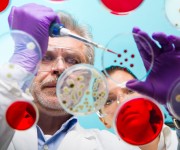24/06/2016
REGENERATING LOST ORGANS WITH FOUR GENES
[THE PROGRESS OF SCIENCE] THE STORY OF A DISCOVERY MADE 10 YEARS AGO, AS TOLD BY MAURO GIACCA (ICGEB)
Il Parco
From “Under the Microscope” – Column of “Il Piccolo” – June 21, 2016
Mauro Giacca – ICGEB
It was the summer of 10 years ago when the magazine Cell published a scientific paper destined to remain in history. Shinya Yamanaka and his post-doc Kazutoshi Takahashi of Kyoto University reported that by introducing just four genes within any cell, it was possible to turn it into an embryonic cell, almost identical to those that were produced in the early stages of development of an organism.
The news quickly spread around the world: laboratories in every country tried to reproduce the data and saw that it actually worked:
it was enough to take a cell from the skin of an individual, or a white blood cell, insert the four genes of Yamanaka, and in a couple of weeks this cell became similar to a cell of the embryo, which is able to proliferate without limits and, under appropriate culture conditions, transform itself into any other cell type.
Already in 2009, more than 300 scientific publications had confirmed the discovery. Yamanaka was awarded with the Nobel Prize in Physiology and Medicine in 2012. The excitement was great, because
for the first time it opened up the possibility of obtaining cells of the heart, brain, retina and of any other organ without having to go through the production of an actual embryo.
Patients with one of the many degenerative diseases, therefore, had available a technique to regenerate lost cells. The first who tried to apply the method to patients was Masayo Takahashi, an ophthalmologist from Kobe, who along with Yamanaka, in 2004 inoculated into the eye of a patient, who had become blind due to retinal degeneration, new retinal cells obtained in the lab from a fibroblast of the skin; the therapy improved the sight of the woman.
However, this patient is the only one treated so far. Last year Yamanaka figured out that the DNA of the cells injected into the eye contained some mutations; as a precaution, the trial was halted. while the debate on how to solve this problem is still going on, the four genes technique by Yamanaka continues to be universally used in laboratories to obtain, starting from the fibroblasts of the skin, cells of the heart, brain, pancreas, and other organs. Since last March, a catalogue is also available, produced by a consortium of public institutions and private companies, of cells derived from patients with a variety of mutations.
These cells can be used as mini-organs in the laboratory to experiment with new customised therapies, an achievement unimaginable just 10 years ago.